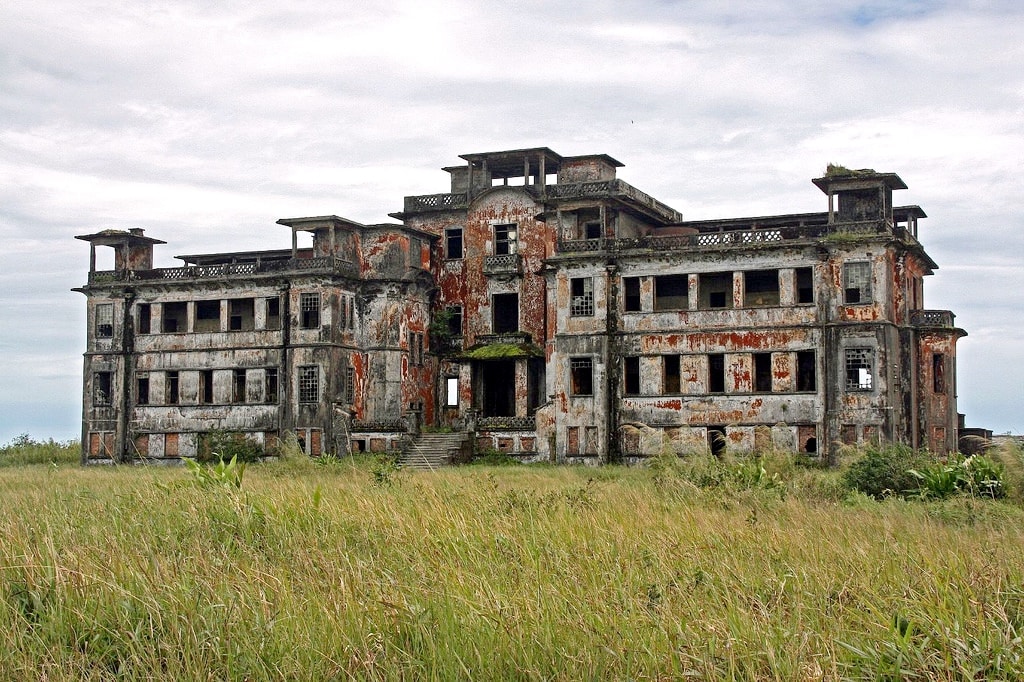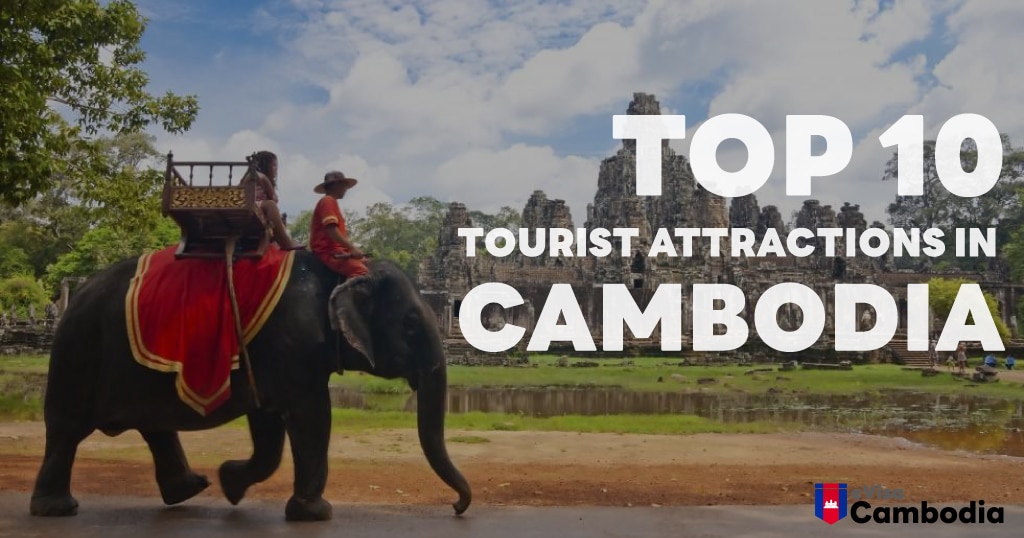10 tourist attractions in Cambodia
Cambodia, renowned for its magnificent Angkor Wat temples and a history scarred by the Khmer Rouge and civil war, presents a unique blend of human achievement and tragedy. While its history is a major draw, this Southeast Asian gem offers much more to explore beyond a quick visit to Siem Reap.
Apart from its iconic temples, Cambodia beckons travelers with its captivating allure. Sun-seekers are enticed by pristine white beaches along the coastline, while adventurous souls find the jungle-clad countryside perfect for exploration. The vibrant capital, Phnom Penh, immerses visitors in the lively rhythm of contemporary Cambodian urban life.
For an unforgettable journey in this captivating country, plan your sightseeing with our list of the “10 Top Tourist Attractions in Cambodia.

1. Angkor Wat
Angkor Wat, translated as the “City Temple,” stands as Cambodia’s most magnificent and extensive among all the Angkor temples, holding the position of the country’s premier tourist attraction. Constructed during the early years of the 12th century under the reign of King Suryavarman II, this temple is renowned for its impeccable balance, composition, and sheer beauty, ranking it among the world’s most exceptional monuments.
Encircled by an expansive rectangular reservoir, Angkor Wat ascends gracefully through three successive rectangular terraces, ultimately reaching the central shrine and tower, soaring to an impressive height of 213 meters (669 feet). This architectural arrangement embodies the traditional Khmer concept of the temple mountain, symbolizing Mount Meru, the celestial abode of Hindu deities.

2. Bayon Temple
As a prominent component of the renowned Angkor complex, the Bayon temple captivates visitors with its array of more than 200 colossal stone visages, gazing in various directions. These enigmatic, smiling faces are widely believed to represent King Jayavarman VII, or perhaps a fusion of his image with that of Buddha, constituting an iconic and instantly recognizable symbol of Angkor.
Erected during the 12th century by King Jayavarman VII as a pivotal element of the expansive Angkor Thom, the Bayon temple occupies the precise center of the royal city, adding to its historical and cultural significance.

3. Banteay Srei
While officially classified as part of the Angkor complex, Banteay Srei is situated approximately 25 km (15 miles) northeast of the primary temple cluster. Due to its relatively remote location, it is often regarded as a distinct attraction in Cambodia. Completed in 967 AD, this temple is predominantly crafted from red sandstone, a material that lends itself to the intricate and well-preserved decorative wall carvings adorning the structure.
Notably, Banteay Srei stands out as the sole major temple at Angkor that wasn’t constructed for a reigning king; instead, it was commissioned by Yajnyavahara, one of King Rajendravarman’s advisors, adding a unique historical dimension to its significance.

4. Koh Ker
Koh Ker briefly served as the capital of the Khmer empire from 928 to 944 AD, during which an array of remarkable structures and colossal sculptures were erected within a short span. The prominent feature of the site is Prasat Thom, a towering temple pyramid standing at 30 meters (98 feet) above the lush surrounding jungle. At its pinnacle, a colossal Garuda, a mythical creature with the form of a half-man and half-bird, is intricately carved into the stone blocks, although it is partially covered now.
For nearly a millennium, Koh Ker remained hidden within the jungle, making it one of Cambodia’s most remote and inaccessible temple destinations. However, recent efforts in demining and the construction of a new toll road have transformed the accessibility of this historic site.

5. Kratie
Kratie, a quaint town nestled along the Mekong River, boasts a central marketplace encircled by charming old French colonial architecture. While it may not be a hub for mass tourism, during the peak season, Kratie welcomes a steady stream of backpackers. Notably, it serves as Cambodia’s premier destination to catch a glimpse of the elusive Irrawaddy dolphins, residing in the Mekong River, though their numbers are unfortunately dwindling. It is estimated that only 66 to 86 of these dolphins remain in the upper Cambodian Mekong region.

6. Bokor Hill Station
Constructed by the French in the 1920s as a respite from the sweltering heat of Phnom Penh, Bokor Hill Station, situated near Kampot, has a tumultuous history. It fell into abandonment twice, first in the 1940s during the Japanese invasion of Cambodia, and later in the 1970s amidst the Khmer Rouge’s reign. Today, the site and its deserted structures evoke an eerie, ghost-town atmosphere. Since October 2008, the road to Bokor has been officially closed for ongoing reconstruction, rendering independent access seemingly impossible. However, travelers can explore the area through hiking tours organized by local travel agencies.

7. Silver Pagoda
Nestled within the Royal Palace grounds of Phnom Penh, the Silver Pagoda serves as a repository for Cambodia’s prized national treasures, including exquisite gold and jewel-adorned Buddha statues. Among these treasures, the most remarkable are a petite 17th-century baccarat crystal Buddha, often referred to as the “Emerald Buddha of Cambodia,” and a life-sized golden Maitreya Buddha adorned with a stunning array of 9,584 diamonds. Enhancing the pagoda’s allure, the inner wall of its courtyard showcases a vibrant and intricately detailed mural depicting the Ramayana myth. This masterpiece was created between 1903 and 1904 by a team of 40 Khmer artists.

8. Tonle Sap
Tonlé Sap, the largest freshwater lake in Southeast Asia, holds significant importance for Cambodia. This expansive lake undergoes remarkable fluctuations in size throughout the seasons. During Cambodia’s dry season, from November to May, Tonlé Sap flows into the Mekong River at Phnom Penh. Conversely, when the heavy rains of the year commence in June, the flow of Tonlé Sap reverses, giving rise to a vast lake. It is within the vicinity of Tonlé Sap that various ethnic Vietnamese and numerous Cham communities have established floating villages, forming vibrant communities along the lake’s shores.

9. Sihanoukville
Sihanoukville, alternatively referred to as Kampong Som, is a coastal city and beachfront getaway nestled along the Gulf of Thailand. Its primary allure lies in its pristine white-sand beaches and the presence of numerous unspoiled tropical islands. Sihanoukville serves as an excellent destination for relaxation and unwinding, although visitors should anticipate larger crowds during the high season or holiday weekends.

10. Preah Vihear
Perched dramatically on a 525-meter (1,722-foot) cliff within the Dângrêk Mountains, on the border shared by Cambodia and Thailand, Preah Vihear stands as a remarkable Khmer temple. This temple boasts arguably the most breathtaking natural setting among all Khmer temples. Its construction primarily occurred during the 11th and 12th centuries, under the rule of Khmer kings Suryavarman I and Suryavarman II, with dedication to the Hindu deity Shiva. Notably, Preah Vihear remains at the center of a longstanding territorial dispute between Thailand and Cambodia, a conflict that resulted in clashes and casualties in 2009.

